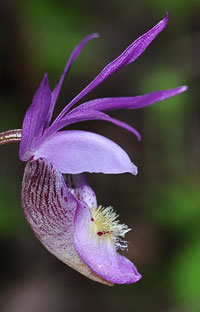 The fairy slipper
The fairy slipper
or calliope orchid
Wildflowers
A wildflower is a flower which grows wild.
Surely, this is a very simple idea: the meaning is clear; the etymology is clear. Yet, although the semantics would seem self evident, the word apparently isn’t transparent to everyone. The Invasive Plant Council of BC offers this rather odd remark: “Often mistaken for wildflowers, invasive plants are spreading through our natural ecosystems….” But, if flowers are spreading without cultivation, they are feral: they are indeed wildflowers. Not all of the ancestors of flowers found in the wild were local, some are from afar. From the point of view of both semantics and this website, if the flowers are wild, they are wildflowers.
Of course, within wildflowers, there are some which were introduced to the region (often inadvertently). These are the invasives—many of which have been thoroughly demonized.
Ok, wildflowers are flowers which grow wild, but how might one organize them? Should one classify by: taxonomy (species, genus…); appearance (colour, petal number…); biogeoclimatic zone (mean temperature, moisture…)?
If one were preparing for a walk, say along the shore of Gibson’s Lake as opposed to Pilot Bay, a grouping by biogeoclimatic zone would be helpful. If one had a flower (or its photograph) removed from other contexts, appearance wins. For the moment, appearance will be the main division here. But as time permits, other choices will be made.
As with other items on this site, these flowers were all photographed in the vicinity of Kootenay Lake: from the lakeshore to adjacent mountaintops. Cultivated flowers are not knowingly included—unless of course, they have escaped the garden and become feral.
Finally, identifications should be viewed as tentative. Indeed, some are labeled as unknown.
Living Landscapes presents Joan Burbridge’s 1989 book: Wildflowers of the Southern Interior.
![]()
